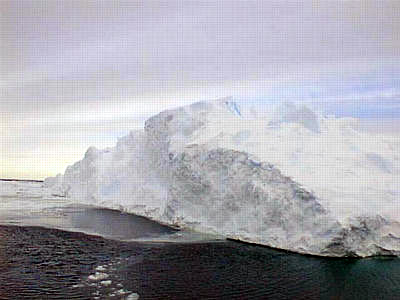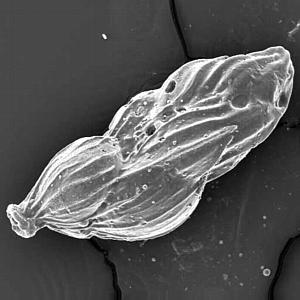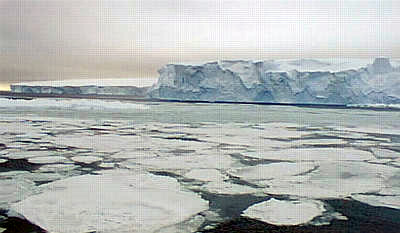
|
|
6 March, 1999
March 6, 1999
Hello from the Nathaniel B. Palmer! Today, we moved east along the
Walgreen Coast toward Pine Island Bay. We had to use satellite images to
help guide us between an area filled with pack ice and another area known
as the Thwaites Iceberg Tongue. The Thwaites Glacier flows into the
Amundsen Sea about 30 miles East of Mount Murphy, Marie Byrd Land. Seaward
of the glacier is a large, floating glacier tongue and an extensive
grounded iceberg tongue. These features stick out nearly 100 miles into
the Amundsen Sea, and we have to make sure and avoid them. We saw lots of
really cool icebergs all day today. In addition, I saw about four minke
whales. One of them was even breaching (jumping up and landing on its
back)!
Let's take some time to look at yesterday's question: "What other types of
critters can be found in the waters surrounding Antarctica?" Of course,
you already know about the whales, seals and penguins. There are also over
270 species of fish. Several species of these fish are interesting because
of their ability to survive in sub-zero waters without freezing. Much like
the insects we discussed yesterday, they have something like antifreeze in
their blood. One such fish that is common in McMurdo Sound is called the
Antarctic cod. These fish live up to 1500 feet below the surface and can
weigh up to 125 pounds!
Another large, predatory group of fish are known as ice fish. They have
clear blood and a pale flesh, which gives them their name. The reason that
their blood is clear is that they have no red blood cells! Red blood cells
normally carry oxygen, so these fish must have other adaptations to get the
oxygen that they need to survive. They have several such adaptations,
including more blood, a larger heart, more gill surface area, and the
ability to exchange oxygen through their tails. A lot of scientists have
studied these unique fish!
Squid are not fish, but they are very common swimmers in the southern
waters. There are at least 20 species of squid in Antarctica, and they
play an important part in the food chain for whales, seals, and birds.
Some of these squid (like the giant squid) live in very deep waters and are
very difficult to study. Squid vary greatly in their adult size --
measuring from only an inch long to as long as 60 feet! Squid move very
quickly in the water, and they have excellent vision. They have several
defense mechanisms to protect themselves. The best known of these is the
ability to squirt black "ink" out to blind or confuse predators.
There are many other marine invertebrates that live on the ocean floor of
the Antarctic waters. Creatures such as sea stars, corals, barnacles,
clams, snails, sponges, sea cucumbers, worms, and sea spiders can be found
on or in the sediments. Because they live on the sea floor and don't swim,
they are considered benthic organisms. Other invertebrates are in the
water, but they are too small or too weak to swim against the currents.
Because they primarily drift with the currents, they are considered
planktonic organisms. A few species of Antarctic zooplankton (animal
plankton) include jellyfish and some foraminifera. PJ has been studying
benthic foraminifera (forams) for her doctoral research.
There are also marine plants in the Southern Ocean. In the intertidal
areas of the southern islands, giant kelp form thick bands like forests
that protect the shores from rough seas. Other types of marine plants
drift with the currents and are called phytoplankton (plant plankton).
Diatoms are a common example of these tiny, single-celled plants that are
at the bottom of the ocean food chain. Diane is conducting research on
diatoms. Diatoms are also the organisms that turn the mud in our cores a
green color.
Although we've already mentioned krill, I want to take a few minutes to
make sure that you know what they are. Krill are the most important
planktonic animal in the Southern Ocean. They feed on phytoplankton, and
they are the prey of almost all the larger organisms in the sea . . .
including fish, seals, whales, and birds (especially penguins). "Krill" is
actually the Norwegian name for Euphausia, a type of pink-colored shrimp.
They can grow to be about two and a half inches long. Large swarms may
involve several million tons of krill and have densities as high as 10,000
organisms per cubic meter. Krill are a potentially valuable source of
protein for human use, and they are easily collected with large nets. They
may be cooked and peeled, or made into things like fish paste or livestock
feed. Today, up to 400,000 tons of krill are caught commercially each
year, mostly from the South Atlantic Ocean.
Some people have written to ask if we eat fish from the Southern Ocean for
dinner. In fact, we had fish tonight . . . but not from the these waters!
All living species in and around Antarctica are protected. In 1961, 12
countries (including the United States) signed the Antarctic Treaty. Today
there are 43 member nations that have signed this treaty and agreed to work
together to protect the unique environment that exists below 60 degrees
South Latitude. Another treaty was passed in 1964 that specifically
protects all animal and plant species in Antarctica. Even people doing
scientific research have to have special permits to collect or kill any
Antarctic wildlife (except in an emergency as food). In 1982, yet another
treaty was enacted that set catch limits and defined fishing seasons and
fishing methods for those parts of the Southern Ocean that aren't protected
by the Antarctic Treaty (north of the boundary for the Treaty, and south of
the Antarctic Convergence). This treaty, the Convention for the
Conservation of Antarctic Marine Living Resources, regulates the harvest of
both krill and fish. Monitoring is done on a regular basis to make sure
that the allowable catches do not affect the populations of birds, seals,
or whales.
Well, that's about all we have time for today. For tomorrow, we'll look at
this new question: How do you suppose that we get fresh water for drinking,
cooking, and washing on the Nathaniel B. Palmer? Thanks for all of the
great questions! I love hearing from you!
Kim Giesting
Latitude: 72 degrees 52 minutes South
Longitude: 110 degrees 04 minutes West
Temperature: -6.3 degrees C
Barometer: 970.0 mb
Wind Speed: 22.1 knots
Wind Direction: 158 degrees (from the Southwest)
Sunrise: 02:44
Sunset: 18:14

. . . and plentiful!

This is a picture of a species of foram called Angulogerina earlandi. It is a single-celled organism that creates its own shell. PJ took this picture with a scanning electron microscope. It's real size is less than half a millimeter long.

The icebergs today were beautiful . . .
Contact the TEA in the field at
.
If you cannot connect through your browser, copy the
TEA's e-mail address in the "To:" line of
your favorite e-mail package.
|
